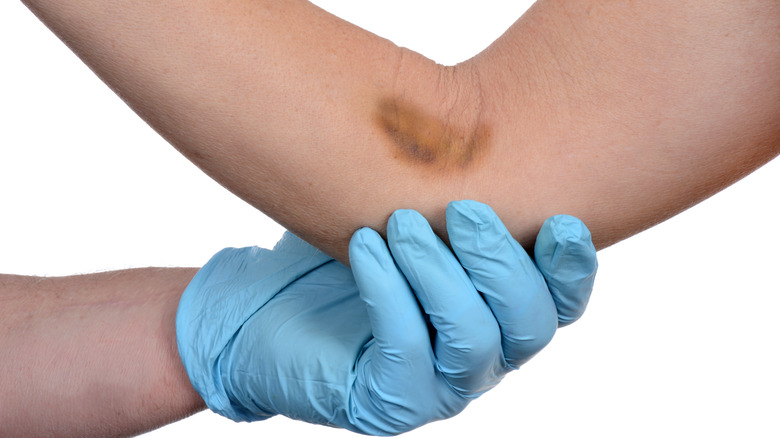Is It Normal To Bruise After Getting Blood Drawn?
Next time you go for your annual physical exam, you might get a blood test simply to help reveal the current state of your health. By assessing a patient's blood sample, doctors are able to determine their risk for certain health conditions, monitor for proper blood clotting and organ function, diagnose conditions such as diabetes or anemia, and check the success of prescribed medications (per the National Heart, Lung, and Blood Institute).
Blood testing is administered through the use of a finger prick test or a small needle to draw blood from a vein in your arm. Following a blood testing procedure, it's not uncommon to experience mild lightheadedness, skin irritation from adhesive from an applied bandage, or soreness (via Healthline). These mild side effects typically resolve themselves in time. But what if you have your blood drawn and experience bruising at the puncture site? Is this normal, or should you be concerned?
How to prevent bruising before and after a blood test
Bruising is considered a common side effect of getting blood drawn (via Healthline). When the small needle is inserted into the vein during blood testing, it damages the skin and blood vessel wall, causing blood leakage which can lead to bruising (per Medical News Today). Not everyone will experience bruising from a blood test, but those on certain medications or with vitamin deficiencies or a history of liver damage may be more susceptible.
Most bruising from blood testing is generally short-lived and resolves on its own. If you have your blood drawn and experience worsening swelling, redness, or inflammation, severe pain at the puncture site, or numbness, tingling, or discoloration in the hand that does not subside, be sure to contact your doctor (via Medical News Today).
The good news is you can take steps to help prevent bruising, both before and after getting blood drawn. According to Medical News Today, wearing loose-fitting clothing and requesting the use of a smaller needle ahead of time can help reduce the likelihood of bruises. Following the procedure, apply pressure to the puncture site and keep the bandage in place for six hours or more before removing it. Also, avoid any heavy lifting, stay hydrated, and help replenish your iron stores and energy level by snacking on nuts, cheese and crackers, or leafy green vegetables (via Healthline).


